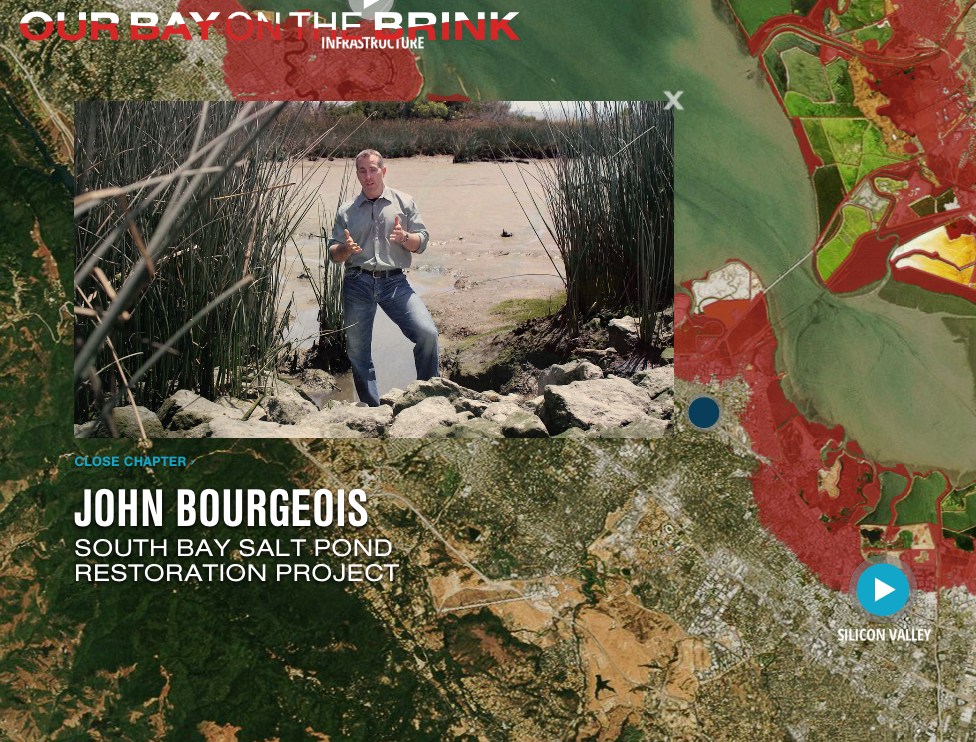A first-ever regional property tax on the June 7 primary ballot is being touted by its sponsors as an issue of environmental protection and public safety. Restoration of badly degraded wetlands and tidal marshes around San Francisco Bay could protect urbanized areas from the threat of intermittent and permanent flooding that could reach as high as 8 feet by the end of this century, they say.
But there is an added benefit that its principals are downplaying: It would benefit the bottom lines of businesses that own, are built on or are developing land at the water’s edge.
Many of the region’s most successful companies — including brand-name companies like Facebook, Google, LinkedIn, Microsoft, Oracle and others — have built headquarters with sweeping bay views at close to zero elevation on land that was reclaimed from bay waters during the past decades.
If successful, regional Measure AA will funnel revenue from a $12-per-parcel property tax into a competitive grant system controlled by the San Francisco Bay Restoration Authority, and is estimated to generate $500 million over 20 years. Under the proposal, which requires approval by two-thirds of voters across nine counties, companies whose land abuts the bay would be eligible to apply for these funds to shore up their own land.
Supporters of Measure AA must persuade voters across a sprawling region — some who live up to 40 miles from the bay — that wetlands restoration matters to them. This public relations campaign began over a year ago with a website called “Our Bay on the Brink.” Through slick videos, maps, and a sophisticated social media strategy, the message of the website was clear: sea level rise is a threat to the public good of the Bay Area. The wetlands need help. A regional approach is the only answer.
The messaging push was supported by many of the same partners of the Yes on AA campaign, including the Silicon Valley Leadership Group, Save the Bay and the Bay Area Council. The need for a public subsidy and the threat to corporate interests, however, was downplayed.
If passed, many of these businesses — even those that senior state planners have criticized for building headquarters on vulnerable and low-lying locations — could be competing with the airports and sewage- treatment plants for dollars to adapt to climate change.
But even if businesses do not apply directly for grant money, these shoreline-hugging companies stand to benefit indirectly, as surrounding intertidal zones are rehabilitated and re-engineered to minimize flood risk. Campaigners for the initiative have been downplaying this benefit to business in the local media blitz.
“I’m not going to say that it isn’t important — it is important,” said Mike Mielke, senior vice president for environment and energy at the Silicon Valley Leadership Group, a San Jose-based business-advocacy organization that has come out as one of the measure’s biggest supporters. “But it is not the first, second or even third most important thing.”
Mielke said the businesses he represents are more concerned with how their employees will be affected by future flooding of highways, hospitals and neighborhoods. “It is the broader infrastructure that is of major concern,” he said.
In the current building boom, fueled by job growth in the technology sector and skyrocketing housing prices, private development on the shoreline has created a windfall for Bay Area developers and for the cities that benefit from a growing tax base.
The San Francisco Public Press published an investigation last summer that found that builders were planning to invest more than $21 billion in new construction in areas prone to flooding from rising seas. In each of 27 proposed large residential and commercial development projects, building plans for low-lying areas had either been approved or were in the approval process.
Increasingly precise and sophisticated scientific models show that by the end of the 21st century, bay waters could rise as high as 8 feet above today’s high tide, during the most extreme kinds of storms.
Measure AA is backed by an unlikely coalition of public agencies, corporate associations and environmental causes.
David Lewis, executive director of the conservation group Save the Bay, has been a key voice in support of Measure AA. He said the point was never to muster private funds to finance the protection of private businesses. Lewis said he could not think of any companies that were planning to apply for grants if the measure passes. “The primary goal is to build tidal marshes around the region,” he said.
But Lewis did say private businesses might be next door to some of the public restoration projects, and some plans might “provide benefits to some adjacent property.”
In March, the president of the San Francisco Board of Supervisors, London Breed, issued a press release listing 10 shoreline- restoration projects as candidates for grant money, some of which are adjacent to large new private developments that have been approved recently or are under construction, and are at or just a few feet above sea level.
The list includes the Yosemite Slough restoration just offshore at Candlestick Point, where Lennar Urban plans to spend $8 billion to build 12,000 homes in the coming decades. Breed’s list also mentioned the design and construction of a new shoreline park at Pier 70, the site of a 28-acre mixed use development, where the average elevation is between 5 feet and 10 feet, set to begin construction in 2017. Developer Forest City has said it would raise the grade of the site.
In the last several years, climate scientists, urban planners and environmental activists have been critical of a recent wave of shoreline development, saying it might leave taxpayers on the hook for expensive fixes down the line. But publicly funded protections may happen much sooner than the experts feared.
In 2014, San Francisco City Hall disregarded an appeal from members of a civil grand jury to impose a moratorium on private developments until stricter building rules are passed. At the time, the group’s corresponding secretary, Maryta Piazza, said the city needed to stay ahead of the trend or end “up spending much more money in the long run.”
At the time, officials, including Mayor Ed Lee, said that changes to the code were premature. “It may be unwise — and expensive — to require immediate measures to adapt to wide-ranging, highly uncertain SLR (sea level rise) projections further out in time,” Lee wrote.
In the last year, a new study conducted by a global catastrophe-and-management firm found that if nothing is done to adapt to rising waters, $77 billion worth of property in the low-lying coastal areas of San Francisco would be at risk in a bad storm by the year 2100. The analysis was conducted by RMS, a consulting firm, and used to inform a plan of action recently released by San Francisco.
How did this unlikely coalition of business and environmental groups link up?
In 2011, California Sen. Dianne Feinstein approached Mielke at a party. She asked for help from the Silicon Valley Leadership Group to promote restoration of tidal marshes and wetlands through a ballot measure.
“She laid it out for us, and we talked about it with her and her staff,” Mielke said. “It was put in front of our members as a challenge.”
Executives of businesses paying dues to the association said that publicly funded wetland restoration could improve the quality of life of its employees by dovetailing with new hiking trails and access to waterfront recreation. “Habitat restoration for fish and fowl, the cleansing properties of wetlands — all of it together was of interest,” Mielke said.
The San Francisco Bay Restoration Authority would collect $12 per parcel in any county touching San Francisco Bay — even inland and coastal areas. That means that multinational companies with acres of waterfront property would pay the same flat fee as individual homeowners. The estimated $500 million would be focused on restoration of tidal marshlands and abandoned salt ponds in the South Bay and the mouth of the Sacramento River Delta.
But local taxpayer associations and other critics say the flat fee, regardless of the size of the parcel, is regressive. The critics argue that corporations like Apple and Google should pay more than residents living in small homes in cities that may not even ring the bay.
Other critics, including the recently resurrected San Francisco Bay Guardian, are concerned that the power of the purse is with a regional agency, the San Francisco Bay Restoration Authority, without clear accountability.
In an editorial that endorsed a “no vote” on Measure AA, the newspaper wrote:
The tax would be levied and administered by the San Francisco Bay Authority, a public agency created by the California Legislature. The Authority is governed by a five-member board of appointees who are chosen by yet another appointee, the president of the Association of Bay Area Governments, which is itself on the verge of a hostile takeover by an autocratic state agency, the Metropolitan Transportation Commission.
So who would decide how to spend the money? Nobody who was elected to that job. Whom do you complain to if you think the decisions are wrong? Good luck with that; SF’s current representative is Scott Wiener, and it’s entirely possible in the future that nobody ever elected by a San Francisco voter (and thus not accountable to any of us) will be doling out our tax dollars.
In a response supporting the measure and the agency, three members of the San Francisco Board of Supervisors said the Bay Guardian did not understand the “powers of the public agency,” which has only one purpose: to raise money for restoring, bettering and protecting the shoreline of the bay.
In a piece titled the “Progressive case for Measure AA,” Supervisors John Avalos, David Campos and Aaron Peskin wrote that the agency:
Has no regulatory authority over San Francisco Bay or its shoreline. It has no say in local government land use entitlement and project permitting decisions. It is even legally prohibited from owning any real property. It can only raise resources by a two-thirds vote of the electorate under its jurisdiction, and it can only allocate resources for wetlands restoration under a specific set of criteria set forth in state statute — a set of criteria that under Measure AA would become even more specific and restrictive.
Increasingly, local media attention has focused on a cumbersome and outdated regulatory system for development on the bay. As part of a newly launched reporting series, the San Francisco Chronicle will be writing about the crumbling Embarcadero and development of the South Bay’s salt marshes.
The Yes on AA campaign website said that the fund could restore nearly 30,000 acres of wetlands that have been degraded by commercial and residential expansion. Conservationists consider wetlands to be one of the most promising strategies to protect communities against sea level rise because they absorb storm surges before making landfall, dampening the force of floods and allowing residents more time to evacuate.
The restoration authority has identified 100 spots around San Francisco Bay that could be eligible for funding. It also created list of potential projects sponsored by mostly environmental groups, parks and public agencies. The list included the East Palo Alto Shoreline, South Bay Salt Pond Restoration and China Basin, among others. No specific locations are specified in the ballot measure.
The restoration authority says the funds would be allocated as follows: 50 percent to the North Bay (Marin, Sonoma, Napa and Solano), the East Bay (Contra Costa and Alameda), South Bay (Santa Clara) and the West Bay (San Mateo and San Francisco), proportional to the size of their populations. The other 50 percent would be handed out without regard to individual counties.
If Measure AA passes, applications for restoration grants would open on a rolling basis in 2018, a year after residents begin paying the parcel tax.
Environmentalist Lewis said this is a good thing for all residents “in roughly equal proportion.”
“Paying a small tax for a huge benefit makes sense,” he said.
Read more in the summer 2015 cover story: “Sea Level Rise Threatens Waterfront Development,” sfpublicpress.org/searise
In case you missed it:
- This Map Shows What San Francisco Will Look Like After Sea Levels Rise — Mother Jones
- Maps of Sea-Level Rise, Ranked from Kinda Scary to OMFG — San Francisco Magazine
- Report: Rising Sea Levels Threaten $21 Billion Development Plans — KQED’s ‘Forum’
- Will $21 billion worth of development around the Bay stand up to sea level rise? — KALW’s “Crosscurrents”
- Your Call: Toxic spill in a Colorado river; the risks of building on the Bay — KALW’s “Your Call”
- Q&A: San Francisco Public Press Reporter Kevin Stark on Sea Level Rise and Bay Area Preparations — Bay Nature
- New report details sea rise threatening development at San Francisco’s edges — San Francisco Examiner
- Major San Francisco Bayfront Developments Advance Despite Sea Rise Warnings — Earth Island Journal
- Mapping The Projected 8 Foot Sea Level Rise In San Francisco — SFist
- Map Shows San Francisco Waterfront At Risk of Severe Flooding — SF Weekly










